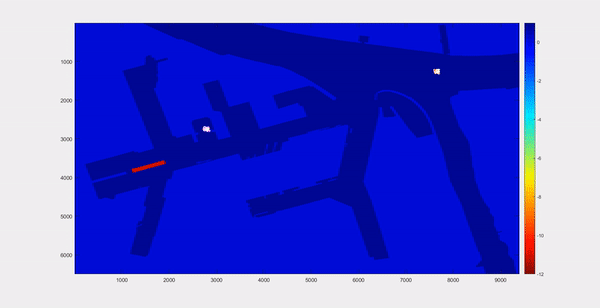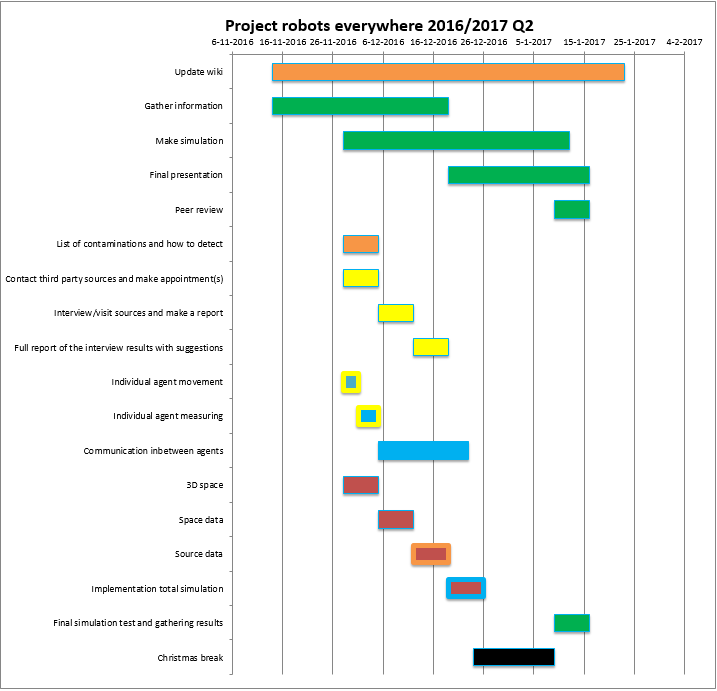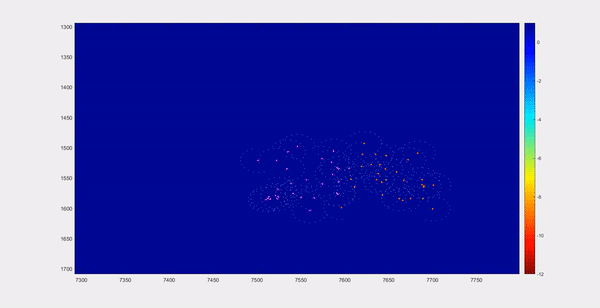PRE2016 2 Groep1: Difference between revisions
| Line 305: | Line 305: | ||
[[file:pH-pollution.png|left|]][[file:pollution.gif|right|]] | [[file:pH-pollution.png|left|]][[file:pollution.gif|right|]] | ||
==== Day/Night cycle ==== | ==== Day/Night cycle ==== | ||
Revision as of 03:58, 23 January 2017
| |||||||||||||
|
You can click the following link for more background information on the course and the project. This link leads to the studyguide that was placed on oase. Week 1The goal of the first week was to decide on a subject for our project and what we were planning to do with this. This started on Monday with the first lecture, where we got more information about the course itself. After this we started brainstorming about different possible ideas to look into. A few examples of the things we looked at were space-exploration, robotic prosthetic and automating hazardous professions like firefighting. In the end we decided on swarm technology. We did still have to specify this so after the meeting we individually looked into some different applications of swarm technology. In the second meeting (17-11) we decided on a final subject: using swarm technology to observe the environment, focused on water like harbors and rivers. Here we want to test the quality of the water by looking at Chemicals, temperature, pH and metals. We decided on making a simulation of the system which can eventually be expanded. The next step was to figure out exactly what we need to make the simulation as realistic as possible, the USE-aspects and how we are going to approach the goal we set for ourselves. Our next meeting (19-11) was focused on combining the results we made throughout the week into a presentation that was to be given the following monday. Week 2
Week 3In week 3 every group started with their individual tasks (as described by the Gantt-chart in week 2). A complete list was made of the different contaminants we would like to investigate and how to do this using different sensors and how they could be applied. For the simulating of the swarm the Matlab application 'Multi-robot simulation' is investigated to check its functions and compatibility with our project. If these results are positive this program can be used to design our system. For the environment a map was made using a picture of the harbor of Rotterdam. A software was used to convert this into a black and white map we can use for our simulation. Detection MethodsA list was made of all different contaminants we could look at for our system. After this methods were found to detect each of these. Following this list, combined with feedback of the users, a final choice can be made for which detection methods to incorporate in the final design. WoodThis was explained by the sea-harbor police as a problem for them. The first option that was looked into was a Gelsight sensor, this sensor can determine what material it is pressed against by comparing its surface to a database. This would however need a drone to have already found the object in the first place. Because of this it would be better to combine cameras with recognition software to find floating objects, regardless of material. OxygenFor oxygen the most practical detection method for our system would be a dissolved oxygen sensor. For the amount of oxygen which can be dissolved in water is influenced by the factors of temperature, pressure and salinity. Because of this a dissolved oxygen sensor also has a thermometer and a barometer. SalinityThe salinity is the amount of salts and similar materials in water. This is directly related to its conductivity. Because of this an electric conductivity meter can be used. pH-valueThe pH-value of water is a good indication of water pollution. Not only do some substances have a very low or high pH-value themselves, thus altering the value of the water when added. A low pH-value also allows (heavy) metals to dissolve more easily, making them mobile. For the pH-value a pH-sensor can be used, as the name implies. Oil spillsAlthough a lot of pollutions can be seen visually by a person, for a drone this can be more difficult. A methods that could be applied to our system for the detection of oil can be using uv-fluorescence. This is based around oil reflecting uv-light, allowing it to be detected. Metals and organic compoundsEspecially heavy metals like mercury or lead or very poisonous. They are considered as some of the most dangerous pollutions possible. A method to detect them could a graphene based sensor, which is also based on electric conductivity. Another method for this could be spectrofoto-analysis. For this a light or laser is filtered and shone through a sample of water. Different materials absorb some wavelengths of the colour spectrum differently. By comparing these to a 'clean' sample the concentration of other substances can be determined. This works not only for metals but also for organic compounds like chlorine or sulfur. These machines can be quiet expansive though. Simulting the EnvironmentCreation of 2D-spaceIn order to create a map for our simulation, we choose to render a map of the harbor into Matlab (we choose a piece of the harbor of Rotterdam called the Botlek). To do this a map of the harbor was taken and firstly edited a bit. The resolution was enhanced, smoothed out and colour-contrast was increased. Using a special script this was then translated into black-and-white picture of the map. This script gives all coordinates of water a value of 1 and the rest a value of 0. After this the resulting Matrix was doubled in size on both axis. Space DataFor the basic conditions of the environment, parameters are given to the matrix created in the 2D-space.
For each of these parameters multiple matrices are made in advance. Then the simulation picks a random value of these matrices for the value of that parameter on a specific coordinate. This is done in order to create a normal distribution and deviation, which is more compliant with reality.
These parameters are made in a similar fashion as previous parameters. Every coordinate is given an appropriate value (combining multiple coordinates to give a realistic image of these factors). Again each coordinate is given a slight deviation using a normal distribution and deviation value. These matrices are again saved.
To simulate this, the black content matrix (used in the creation of the 2D space) is multiplyied with an appropriate light intensity value, changing over time. This is saved as a new matrix. Swarm systemMatlab was chosen to simulate the swarm. Firstly because we are familiar with the software and coding language, and we think it is capable of what we need. Secondly to ensure compatibility, since the virtual world is also made in Matlab. We found a program called MultiRobotSimulator (MRsim) which we studied to see how we could simulate a swarm. In order to create a realistic simulation of a swarm of boatbots, it is important to understand which physical characteristics of these boatbots will influence their behavior. A list with educated guesses was made for this as part of the simulation-inventory, where these are described fully, including used sources. By choosing or comparing to off-the-shelf technology, this makes sure that our assumptions are realistic, and also makes the design-process more USE-based, specifically the entrepreneurial/market dimension.
As in previous weeks, the notes of our other meetings are linked to down below: This following link is a link to our Dropbox files for this week. There all the files we worked on can be seen to clarify anything missing from the description above. Week 3: [2] Week 4In week 4 we made our progress according to the Gantt-chart. User-communicationWe ran into a problem however when we tried to arrange meetings with the different institutes we contacted earlier. The company that designed the Wasteshark no longer works on this project, we did try to contact its original designer but he has not responded yet. The harbor of Rotterdam turned us down, saying they did not have time for us and HEBO Cat. BV can only see us starting January. We did have contact with the police of Rotterdam though and they have can meet us next week. What he could already tell us that the driftwood they have trouble with differ in seize from 20 cm to entire pallets. SimulationDrone movementsMeanwhile in the simulation, the general movements of 1 drone have been made. It can move around an environment without bumping into the sides, move in steps and make use of a hub. For the more complex algorithms, like communicating with his fellow drones, research was done to see if there is already a foundation for us to work with. For this we found an article describing multiple parameters we can use for our program. EnvironmentFor the environment multiple aspects were finalized. A day-and-night cycle was made using scalars based on the current time of year. This can be influenced by clouds and the time of year can also be changed. Wind was added using the same principle as the pH-value from week 3. The difference here is that wind is not a scalar but a vector, adding a direction. The angle this vector can change will be in a fixed range to keep the entire system more realistic. Also a script was made to add currents to the system, for this the Finite-Element-Method is used. However running this script to add it to the simulation takes quiet a while. Size dronesIn order to determine the size of the drones the law of Archimedes was used, which states the downwards force should be equal or less to the upwards force for something to float. To use this the mass of the different components were combined to create a total mass of the drone. This then results in a volume that can be translated to a total volume or area. Using this it was decided to make the drones have an area of approximately 0.8 squared meters. If more components are added to the drone the minimal required size can easily be recalculated using this method.
Like in previous weeks we had extra meetings, here are the notes of those meetings This following link is a link to our Dropbox files for this week. There all the files we worked on can be seen to clarify anything missing from the description above. Week 4: [3] Week 5This week was pretty similar to previous weeks. While the simulation teams worked on their parts of the simulation, they were supported by the research teams to make sure they have all the information they need. ResearchThe biggest points we needed to make clear this month were: 1) Why do we choose swarm-robotics to solve the problem we have been presented with. 2) What are the requirements for this system With the problem being driftwood in a harbor (for which we choose the Botlek in Rotterdam as an example) and observing the quality of the water as added task. For this we made a list of requirements we needed of the systems. Using this list we were able to draw conclusions on why we use swarm-robotics. This list of requirements was then increased to also contain the requirements we have for the system itself. This list can be found in the Notes of meeting 15-12. Also in order to be able to solve the driftwood problem, more information was found on object-recognition software. What was found is that there is a lot of software available on this which all works on the principle of comparing the input of images from a camera with a database of recognizable object. When a match is found it is thus recognized. For the communication between the drones multiple data transmission methods were looked at to check their range. This can be quiet small, like a Bluetooth connect with a maximum of around 30 meters. Or a big transmitter, able of sending data thousands of meters. For our application it is needed to keep the equipment quiet small to be able to fit it into the separate drones, while also trying to get the production costs reasonable. For this the best option seems to be a strong WiFi-signal witch can range to around 1000 meters with the right setup. SimulationMeanwhile work on the simulation also continued. The hardest challenge here this week was to simulate the streams present in the system. These turned out to be quiet complex not only in the main rivers of the Oude Maas and the Nieuwe Maas, but also within the piece of harbor itself. The tides are also a factor in this that had previously not been included yet. In the end it was decided to neglect the flows within the Botlek itself (but not hose in the Oude- and Nieuwe Maas) because it would not add anything significant to would be missing using only the streams in the main rivers. In order to help the drones with their assignment of detecting the maximum of a contamination, as well as mapping their environment, we have decided to add a sensor to detect the direction and speed of the flow around them. In the end a complex map was made of these stream which can be found in the Dropbox folder below. In here a Matlab script can be found containing a detailed explanation of how it works and what it does. Meanwhile all different movements were defined for the swarm. These were also tested and found to be working in the simulation itself. This allows the separate drones to move from and towards different sections of the environment and deal with obstacles it faces along the way like other boats or driftwood.
This following link is a link to our Dropbox files for this week. There all the files we worked on can be seen to clarify anything missing from the description above. Week 5: [4] Week 6For week 6 the main goal was to improve the requirements that were made in week 5. At the moment these were not defined clearly and also needed to be specified more. Besides this we made contact with the RWS to see the problem first-hand. We made an appointment with them where, besides getting more information, also join them on the waters around Eindhoven. Although Eindhoven has a different scale than Rotterdam when looking at driftwood in the harbors, it should still offer a good image. Meanwhile in the simulation, a script was made to combine the different movements of the drones. This results in an algorithm for the swarm to form a path in the harbor of Rotterdam. As usual, the following link leads to our Dropbox files for this week. Week 6: [5]
Week 7Technically week 8, but we decided to not skip a week in our counting. Not a lot of work was done during the holidays, but were immediately picked up in the first week of the new year again. This included a visit to Rijkswaterstaat (RWS) in Echt near Sittard for more information and a lot of work on the simulation itself. RijkswaterstaatOn the 4th of January, Ralf, Zjeraar and Stijn had a meeting with people of the RWS on one of their patrol boats to ask some questions that could be useful for our design. Although hesitant at first, it turned out that the people of the RWS saw some really nice use for the system we are designing. Not only for what we already had in mind, but they also gave some examples of other way the system could be used. This gave a nice boost to the viability of our system since it turned out to be able to applied in a lot more situations on a lot more locations. Some of the examples they gave were for instance to not only use the drones to move driftwood, but also pieces of ice, or to help find missing persons in the water (which turned out to be needed quiet frequent). We had a number of questions we asked them to gain more insight into how the quality of the water is being controlled at the moment, how driftwood or other objects form a problem on the water and how this gets solved. It was also explained how the regulations work in regards to pollution of the water and how our system could help here. SimulationMeanwhile in the simulation work continued. The team responsible for simulating the environment added scripts to simulate driftwood in the water and how this moves through the system thanks to flow and wind. This was also done for pollutions, these can now be added to the system which then calculates and shows how these move and change in the rivers of our environment. At the moment this was done for pollutions altering the pH-value of the water but this can easily be copied to be applied to change the electro-conductivity or oxygen concentration of the water. The swarm team ran into some difficulty though, this is still behind schedule and although progress is being made, it is going slower than anticipated. At the moment scripts were made to have the swarm divide itself and prioritize certain tasks and the movements of the drones are finalized. One of the hurdles that were found was to have a drone that looking around for driftwood to determine the exact location of a piece of wood, instead of just acknowledging wood being in its vicinity.
As usual, the following link leads to our Dropbox files for this week. Week 6: [6] Week 8This is the final week to work on the simulation and this is what we focused heavily on. A lot of work still needed to be done to finish the script for the swarm. This then had to be combined with the script for the environment and the combination has to be run in order to get results. These results then had to be analysed and all of this had to be put together in order to present it on Monday the 16th. We had multiple meetings during the week to make sure everything was finished. Of these meetings only our meeting on Monday the 9th had notes made of them which are linked here. Final explanationHere will be a final explanation of all the different aspects of the project. Not only of the simulation but also of the contact with the projected users, the requirements and the choice for our system, These last two can be found in the files added here. The first of these is a full list of the requirements made for the system. The second is an explanation why swarm robotics is used for our problem instead of other options. SimulationAs explained before, the simulation is divided into two mayor parts: the environment and the swarm. This was done to independently focus on the proper working of the separate parts, which could then be combined to create a detailed whole. EnvironmentThe environment was again divided into sub-parts. These divisions were named the 3D-space (containing the map of the simulation), the source data (containing currents, pH-values, wind and day/night cycles) and finally the space-data containing driftwood, pollutions and other traffic. MapThe map on which the swarm operates, is a pre-made matrix in a script that reads an image, and based on the color of the image assigns a 1 or 0 per pixel. The image in the case of this project is an on top view of the Botlek harbour. This image was manually enlarged to ensure enough pixels would be present, since a scale can be assigned (real life distance per pixel) which should not be too small. With the chosen pixel size, namely 9400 width by 6498 height, a pixel is roughly 50 by 50 cm.
pHThe pH-values are also predefined, since the values differ per pixel. If those values would have to be calculated in the simulation, a lot of the total computation time would be used on this operation. To add some sort of randomness, three separate pH matrices are made, and for every time step one of these three matrices are chosen to be the pH present on the map. The values given to all the pixels are chosen by picking a value from a normal distribution, with a mean of 8.388 and a standard deviation of 0.004. The script to make those matrices could also be used for other pollution related that have to be measured in order to find a conclusion whether there's pollution or not.
pH contaminationsCreates an initial pollution and then creates a matrix containing this data which will then change over time depending on current and wind speed. This creates a pollution that has to increase or decrease the value of the overall pH-matrix. Swarm observation threshold for the final simulation should be 8.388 +/- 0.5. So values below 8.388-0.5 or above 8.388+0.5 are considered to be a pollution. Here a pollution is visualized. On the left there is an image of how a pH pollution is defined in the simulation. On the right a video is placed where a contamination enters the system on the bottom right corner of the system and then moves through the river. 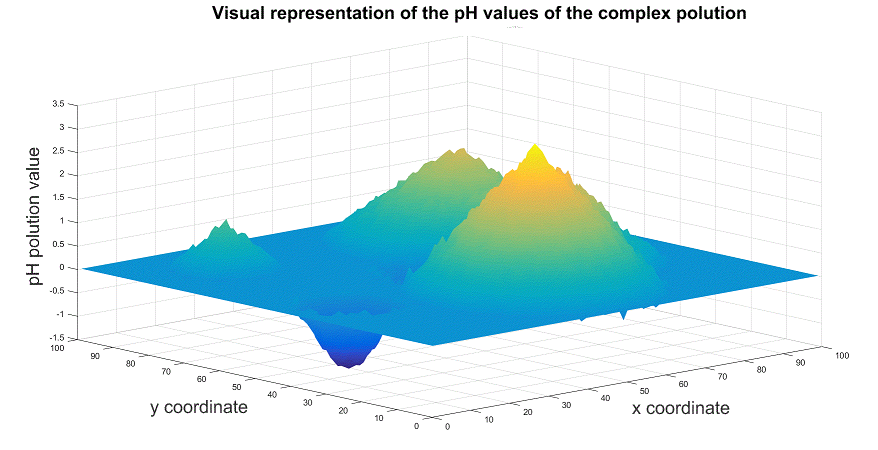 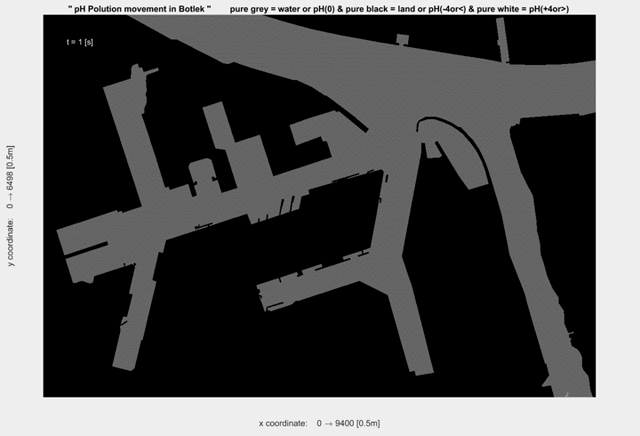
Day/Night cycleThe length of a day/night cycle differs per day of the year. Considering when this part of the script was made, 22 December[1], the shortest day of the year was chosen to model the cycle. Realistically, the curve which gives the light level varies per day. Since in the simulation one time step equals one second of simulation time, a day consists of 24*60*60 time steps, which is 86400 time steps. From 16:30 till 7:30, no light is present, and from 7:30 till 16:30, the function of the light follows half of a sine period, with a peak at 12:00 with an amplitude of 200Wm-2. Source: [1] Burgess, P. (2009, 29 september). VARIATION IN LIGHT INTENSITY AT DIFFERENT LATITUDES AND SEASONS, EFFECTS OF CLOUD COVER, AND THE AMOUNTS OF DIRECT AND DIFFUSED LIGHT. Retrieved from http://www.ccfg.org.uk/conferences/downloads/P_Burgess.pdf WindWind direction is based on the probability of a certain wind direction on a given day, based on real life data [2]. A random value is generated every 10800 time steps (this value can be changed in the simulation), which when generated will determine the wind direction. A normal value with a mean of 10 and a standard deviation of 0.5 is chosen for the wind strength. Source: [2] https://www.windfinder.com/weatherforecast/rotterdam_airport BoatsBoats are implemented in the simulation in order to see the swarm's behaviour when encountering other traffic. There's only one size boat in the simulation, namely a container ship which has a length of 367m (734pixels) and a width of 50m (100pixels). This ship has two routes, in one route the boat will start in the port, in the southwest part of the map, and will go towards sea, which is at the northwest part of the map. In the other route, this route is reversed. The boats and its routes can be clearly seen in the simulation video. The swarm will have to avoid the boat, and not the other way around. Also, the swarm should be careful when the boat turns, since the boat is fairly long, the ends of the boat rotate fast.
SwarmThe swarm system implemented in our simulation is very useful for the fast exploration of different types of water surfaces, such as lakes and rivers in all sort of shapes and sizes. Depending on the size of the surface you wish to explore, you might want to increase the size of the swarm. It could also be desired to use multiple swarms, to explore the area in less time. For our simulation usually two swarms, consisting of 30 drones each, were used in different position of the Botlek part in the Rotterdam harbour. The purpose of our swarm, however, is not only to explore the area, but then to check if any pollution, in and on the water, is present. When the pollution is placed on top of the water, our drones will cooperate to remove these obstacles. Each swarm consists of 30 robots which all have one of three different types, the amount of each can be determined before running the simulation. Apart from different behaviour when near the shore, all robot types act the same. It is still very useful to have 3 different robot types, because it enables multiple forms of exploration and makes it easier for the swarm to adapt to different situations. Type 1: This robot type will follow the shore upon contact. This means that it follows a certain path while staying close to the shore, either on the left or the right side of the drone. Even when a corner comes, it will still follow this. This robot type is especially useful to implement in areas with complex geometrical structures, because it enables the robot to always escape these areas. It is also great for places where it is dangerous if anything is in the middle of the water, such as boat routes. Type 2: This robot type will act similar to type 1 at first and follow the shore, but whenever a turn appears, this type of robot will move straight ahead, this is really useful to have in your swarm when there are a lot of places where multiple rivers come together or there are a lot of small islands in the water, where type 1 would keep turning circles around. Similar to type 1 it is also great to implement in places where the middle is dangerous, however type 1 would stay safer. Type 3: When in contact with the shore, this type of drone will ‘bounce’ of the shore, with an angle equal to the angle it arrived. This type of drone is most likely to be implemented in large areas of water or wide rivers. Although each robot type has different qualities, it is advised to at least have a couple of each type in your swarm.
Evaluation USE aspectIn the last couple of weeks our group encountered how much of an impact the user can have on the design of your technology. We started as a group wanting to do something big. Our common interest came down to a swarm technology, at first for exploring unknown places like Mars or the deep parts of the Ocean. But soon we came to the conclusion that we really need to have a good defined problem in order to go further with our swarm technology. We came up with the idea to monitor large bodies of water in industrialized areas on heavy pollution. We started to look and ask around. We contacted companies like Rijkswaterstaat, de Waterschappen the harbor police of Rotterdam and some others. At first glance these companies were interested but when asked what the real problems are they could not give a concrete answer. Until we made contact with a police officer from Rotterdam who would like to help us. He said that driftwood in the harbor of Rotterdam was a noticeable problem for his colleagues. It looked like we had found a real problem. But the question that arose was: how big is this problem. The police agent gave us a new contact to help us further. This was the Environmental police of Dordrecht. This police agent was very interested and gave us some deeper insight into harbor pollution. They have strict rules on water pollution which has improved the water quality greatly over the last 20 years. But for further insight he brought us in contact with another colleague. He told us that pollution was incidental and the same with driftwood. The problem of driftwood was in his eyes not a very big problem. But to get a real feeling of how pollution monitoring works he brought us in contact with someone from Rijkswaterstaat to make an appointment with 2 sailors who monitor the Maas river in Limburg. We had an interview with them which cleared a lot of things for us. The interview can be found in the pdf-file below. The interview gave us insight in what the problems really are, and this changed our goal for our swarm drastically. Instead of focusing on one particular problem like driftwood, we now focus on all different kind of objects in the water, from Big-Bags, plastics and wood to algae, and even (dead) bodies. This may not always form a dangerous problem for the big professional boats but does for the small recreational boats. This all has thought us that in order to come up with a good design constant interactions with the user is needed in order to prevent technocracy, which would lead eventually to a product that no one would use. |
